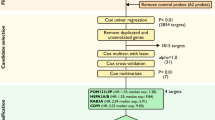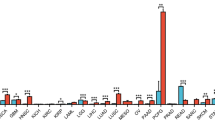Abstract
To evaluate the predictive value of genes involved in resistance to platinum-taxane chemotherapy in patients with epithelial ovarian cancer (EOC). Microdissected formalin-fixed tumoral samples from 187 EOC patients’ primary tumors (90 and 97 samples from matched patients in the experimental and validation sets, respectively) were analyzed. All specimens were analyzed for ATP7b, BRCA1, BRCA2, PARP1, UIMC1(RAP80), HOXA9, DAXX, TXN (TRX1), THBS1 (TSP1) and PRR13 (TXR1) mRNA expression by quantitative real-time PCR. Most of the patients (172 out of 187) received front-line carboplatin-paclitaxel regimen. Expression levels were correlated with overall (OS) and progression-free (PFS) survival by multivariate analysis. Patients with high TXN and THBS1 expression presented longer PFS (P=0.001 and P<0.001, respectively) and OS (P=0.024 and P<0.001, respectively). High TXR1 expression was associated with decreased PFS (P<0.001) and OS (P<0.001). Multivariate analysis demonstrated that high PRR13/low THBS1 expression was an independent factor for decreased PFS (hazards ratio: 1.94; 95% confidence interval (CI): 1.48–2.92; P=0.008) and OS (hazard ratio: 3.89; 95% CI: 2.16–6.87; P<0.001), whereas low TXN expression was correlated with decreased PFS (hazard ratio: 1.44; 95% CI: 1.05–2.84; P=0.043) and OS (hazard ratio: 2.38; 95% CI: 1.78–2.77; P=0.009). These findings indicate that PRR13/THBS1 and TXN expression could be used for the prediction of resistance to treatment of EOC patients and, therefore, merit to be further evaluated.
This is a preview of subscription content, access via your institution
Access options
Subscribe to this journal
Receive 6 print issues and online access
$259.00 per year
only $43.17 per issue
Buy this article
- Purchase on Springer Link
- Instant access to full article PDF
Prices may be subject to local taxes which are calculated during checkout

Similar content being viewed by others
References
Jelovac D, Armstrong DK . Recent progress in the diagnosis and treatment of ovarian cancer. CA Cancer J Clin 2011; 61: 183–203.
Kyrgiou M, Salanti G, Pavlidis N, Paraskevaidis E, Ioannidis JP . Survival benefits with diverse chemotherapy regimens for ovarian cancer: meta-analysis of multiple treatments. J Natl Cancer Inst 2006; 98: 1655–1663.
Bast RC Jr. . Molecular approaches to personalizing management of ovarian cancer. Ann Oncol 2011; 22: viii5–viii15.
Rabik CA, Dolan ME . Molecular mechanisms of resistance and toxicity associated with platinating agents. Cancer Treat Rev 2007; 33: 9–23.
Perez EA . Microtubule inhibitors: Differentiating tubulin-inhibiting agents based on mechanisms of action, clinical activity, and resistance. Mol Cancer Ther 2009; 8: 2086–2095.
Komatsu M, Sumizawa T, Mutoh M, Chen ZS, Terada K, Furukawa T et al. Copper-transporting P-type adenosine triphosphatase (ATP7B) is associated with cisplatin resistance. Cancer Res 2000; 60: 1312–1316.
Ferry KV, Hamilton TC, Johnson SW . Increased nucleotide excision repair in cisplatin-resistant ovarian cancer cells: role of ERCC1-XPF. Biochem Pharmacol 2000; 60: 1305–1313.
Smith S, Su D, Rigault de la Longrais IA, Schwartz P, Puopolo M, Rutherford TJ et al. ERCC1 genotype and phenotype in epithelial ovarian cancer identify patients likely to benefit from paclitaxel treatment in addition to platinum-based therapy. J Clin Oncol 2007; 25: 5172–5179.
Tutt A, Ashworth A . The relationship between the roles of BRCA genes in DNA repair and cancer predisposition. Trends Mol Med 2002; 8: 571–576.
Yoshida K, Miki Y . Role of BRCA1 and BRCA2 as regulators of DNA repair, transcription, and cell cycle in response to DNA damage. Cancer Sci 2004; 95: 866–871.
Farmer H, McCabe N, Lord CJ, Tutt AN, Johnson DA, Richardson TB et al. Targeting the DNA repair defect in BRCA mutant cells as a therapeutic strategy. Nature 2005; 434: 917–921.
Sobhian B, Shao G, Lilli DR, Culhane AC, Moreau LA, Xia B et al. RAP80 targets BRCA1 to specific ubiquitin structures at DNA damage sites. Science 2007; 316: 1198–1202.
Kim H, Chen J, Yu X . Ubiquitin-binding protein RAP80 mediates BRCA1-dependent DNA damage response. Science 2007; 316: 1202–1205.
Quinn JE, James CR, Stewart GE, Mulligan JM, White P, Chang GK et al. BRCA1 mRNA expression levels predict for overall survival in ovarian cancer after chemotherapy. Clin Cancer Res 2007; 13: 7413–7420.
Cheng W, Liu J, Yoshida H, Rosen D, Naora H . Lineage infidelity of epithelial ovarian cancers is controlled by HOX genes that specify regional identity in the reproductive tract. Nat Med 2005; 11: 531–537.
Widschwendter M, Apostolidou S, Jones AA, Fourkala EO, Arora R, Pearce CL et al. HOXA methylation in normal endometrium from premenopausal women is associated with the presence of ovarian cancer: a proof of principle study. Int J Cancer 2009; 125: 2214–2218.
Goldberg AD, Banaszynski LA, Noh KM, Lewis PW, Elsaesser SJ, Stadler S et al. Distinct factors control histone variant H3.3 localization at specific genomic regions. Cell 2010; 140: 678–691.
Drane P, Ouararhni K, Depaux A, Shuaib M, Hamiche A . The death-associated protein DAXX is a novel histone chaperone involved in the replication-independent deposition of H3.3. Genes Dev 2010; 24: 1253–1265.
Gallegos A, Gasdaska JR, Taylor CW, Paine-Murrieta GD, Goodman D, Gasdaska PY et al. Transfection with human thioredoxin increases cell proliferation and a dominant-negative mutant thioredoxin reverses the transformed phenotype of human breast cancer cells. Cancer Res 1996; 56: 5765–5770.
Gasdaska JR, Berggren M, Powis G . Cell growth stimulation by the redox protein thioredoxin occurs by a novel helper mechanism. Cell Growth Differ 1995; 6: 1643–1650.
Saitoh M, Nishitoh H, Fujii M, Takeda K, Tobiume K, Sawada Y et al. Mammalian thioredoxin is a direct inhibitor of apoptosis signal-regulating kinase (ASK) 1. EMBO J 1998; 17: 2596–2606.
Welsh SJ, Bellamy WT, Briehl MM, Powis G . The redox protein thioredoxin-1 (Trx-1) increases hypoxia-inducible factor 1alpha protein expression: Trx-1 overexpression results in increased vascular endothelial growth factor production and enhanced tumor angiogenesis. Cancer Res 2002; 62: 5089–5095.
Woolston CM, Deen S, Al-Attar A, Shehata M, Chan SY, Martin SG . Redox protein expression predicts progression-free and overall survival in ovarian cancer patients treated with platinum-based chemotherapy. Free Radic Biol Med 2010; 49: 1263–1272.
Kakolyris S, Giatromanolaki A, Koukourakis M, Powis G, Souglakos J, Sivridis E et al. Thioredoxin expression is associated with lymph node status and prognosis in early operable non-small cell lung cancer. Clin Cancer Res 2001; 7: 3087–3091.
Lih CJ, Wei W, Cohen SN . Txr1: a transcriptional regulator of thrombospondin-1 that modulates cellular sensitivity to taxanes. Genes Dev 2006; 20: 2082–2095.
Lawler J . Thrombospondin-1 as an endogenous inhibitor of angiogenesis and tumor growth. J Cell Mol Med 2002; 6: 1–12.
Papadaki C, Mavroudis D, Trypaki M, Koutsopoulos A, Stathopoulos E, Hatzidaki D et al. Tumoral expression of TXR1 and TSP1 predicts overall survival of patients with lung adenocarcinoma treated with first-line docetaxel-gemcitabine regimen. Clin Cancer Res 2009; 15: 3827–3833.
Changes in definitions of clinical staging for carcinoma of the cervix and ovary: International Federation of Gynecology and Obstetrics. Am J Obstet Gynecol 1987; 156: 263–264.
Sorbe B, Frankendal B, Veress B . Importance of histologic grading in the prognosis of epithelial ovarian carcinoma. Obstet Gynecol 1982; 59: 576–582.
Harsch M, Bendrat K, Hofmeier G, Branscheid D, Niendorf A . A new method for histological microdissection utilizing an ultrasonically oscillating needle: demonstrated by differential mRNA expression in human lung carcinoma tissue. Am J Pathol 2001; 158: 1985–1990.
Kazerounian S, Yee KO, Lawler J . Thrombospondins in cancer. Cell Mol Life Sci 2008; 65: 700–712.
Galluzzi L, Senovilla L, Vitale I, Michels J, Martins I, Kepp O et al. Molecular mechanisms of cisplatin resistance. Oncogene 2012; 31: 1869–1883.
Stewart DJ . Mechanisms of resistance to cisplatin and carboplatin. Crit Rev Oncol Hematol 2007; 63: 12–31.
Nakayama K, Kanzaki A, Ogawa K, Miyazaki K, Neamati N, Takebayashi Y . Copper-transporting P-type adenosine triphosphatase (ATP7B) as a cisplatin based chemoresistance marker in ovarian carcinoma: comparative analysis with expression of MDR1, MRP1, MRP2, LRP and BCRP. Int J Cancer 2002; 101: 488–495.
Nakayama K, Kanzaki A, Terada K, Mutoh M, Ogawa K, Sugiyama T et al. Prognostic value of the Cu-transporting ATPase in ovarian carcinoma patients receiving cisplatin-based chemotherapy. Clin Cancer Res 2004; 10: 2804–2811.
Carser JE, Quinn JE, Michie CO, O'Brien EJ, McCluggage WG, Maxwell P et al. BRCA1 is both a prognostic and predictive biomarker of response to chemotherapy in sporadic epithelial ovarian cancer. Gynecol Oncol 2011; 123: 492–498.
Lesnock JL, Darcy KM, Tian C, Deloia JA, Thrall MM, Zahn C et al. BRCA1 expression and improved survival in ovarian cancer patients treated with intraperitoneal cisplatin and paclitaxel: a Gynecologic Oncology Group Study. Br J Cancer 2013; 108: 1231–1237.
Weberpals J, Garbuio K, O'Brien A, Clark-Knowles K, Doucette S, Antoniouk O et al. The DNA repair proteins BRCA1 and ERCC1 as predictive markers in sporadic ovarian cancer. Int J Cancer 2009; 124: 806–815.
Steffensen KD, Waldstrom M, Jakobsen A . The relationship of platinum resistance and ERCC1 protein expression in epithelial ovarian cancer. Int J Gynecol Cancer 2009; 19: 820–825.
Darcy KM, Tian C, Reed E . A Gynecologic Oncology Group study of platinum-DNA adducts and excision repair cross-complementation group 1 expression in optimal, stage III epithelial ovarian cancer treated with platinum-taxane chemotherapy. Cancer Res 2007; 67: 4474–4481.
Papadaki C, Tsaroucha E, Kaklamanis L, Lagoudaki E, Trypaki M, Tryfonidis K et al. Correlation of BRCA1, TXR1 and TSP1 mRNA expression with treatment outcome to docetaxel-based first-line chemotherapy in patients with advanced/metastatic non-small-cell lung cancer. Br J Cancer 2011; 104: 316–323.
Zhang X, Lawler J . Thrombospondin-based antiangiogenic therapy. Microvasc Res 2007; 74: 90–99.
Alvarez AA, Axelrod JR, Whitaker RS, Isner PD, Bentley RC, Dodge RK et al. Thrombospondin-1 expression in epithelial ovarian carcinoma: association with p53 status, tumor angiogenesis, and survival in platinum-treated patients. Gynecol Oncol 2001; 82: 273–278.
Arner ES, Holmgren A . The thioredoxin system in cancer. Semin Cancer Biol 2006; 16: 420–426.
Powis G, Kirkpatrick DL . Thioredoxin signaling as a target for cancer therapy. Curr Opin Pharmacol 2007; 7: 392–397.
Kawahara N, Tanaka T, Yokomizo A, Nanri H, Ono M, Wada M et al. Enhanced coexpression of thioredoxin and high mobility group protein 1 genes in human hepatocellular carcinoma and the possible association with decreased sensitivity to cisplatin. Cancer Res 1996; 56: 5330–5333.
Kim SJ, Miyoshi Y, Taguchi T, Tamaki Y, Nakamura H, Yodoi J et al. High thioredoxin expression is associated with resistance to docetaxel in primary breast cancer. Clin Cancer Res 2005; 11: 8425–8430.
Raffel J, Bhattacharyya AK, Gallegos A, Cui H, Einspahr JG, Alberts DS et al. Increased expression of thioredoxin-1 in human colorectal cancer is associated with decreased patient survival. J Lab Clin Med 2003; 142: 46–51.
Acknowledgements
This work was partially supported by research grants from the Cretan Association for Biomedical Research (CABR) and the Hellenic Society of Medical Oncology (HeSMO).
Author information
Authors and Affiliations
Corresponding author
Ethics declarations
Competing interests
The authors declare no conflict of interest.
Additional information
Supplementary Information accompanies the paper on the The Pharmacogenomics Journal website
PowerPoint slides
Rights and permissions
About this article
Cite this article
Pontikakis, S., Papadaki, C., Tzardi, M. et al. Predictive value of ATP7b, BRCA1, BRCA2, PARP1, UIMC1 (RAP80), HOXA9, DAXX, TXN (TRX1), THBS1 (TSP1) and PRR13 (TXR1) genes in patients with epithelial ovarian cancer who received platinum-taxane first-line therapy. Pharmacogenomics J 17, 506–514 (2017). https://doi.org/10.1038/tpj.2016.63
Received:
Revised:
Accepted:
Published:
Issue Date:
DOI: https://doi.org/10.1038/tpj.2016.63
This article is cited by
-
Chromatin accessibility changes at intergenic regions are associated with ovarian cancer drug resistance
Clinical Epigenetics (2021)
-
Death domain-associated protein (DAXX) expression is associated with poor survival in metastatic high-grade serous carcinoma
Virchows Archiv (2020)
-
Higher expression of calcineurin predicts poor prognosis in unique subtype of ovarian cancer
Journal of Ovarian Research (2019)
-
FN1, SPARC, and SERPINE1 are highly expressed and significantly related to a poor prognosis of gastric adenocarcinoma revealed by microarray and bioinformatics
Scientific Reports (2019)



